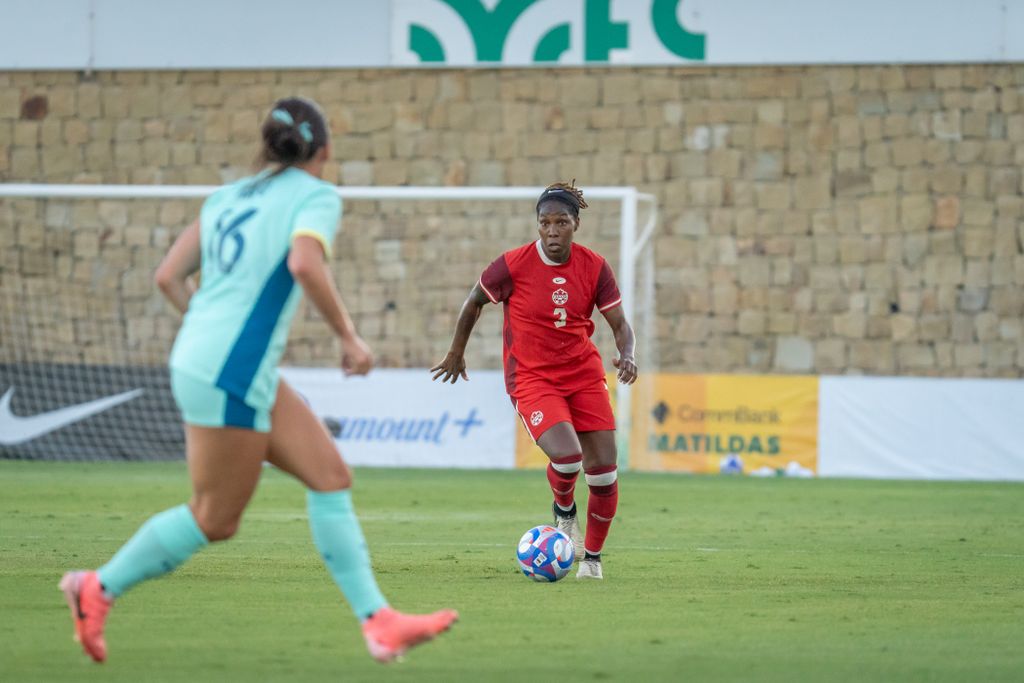What we learned from CanWNT's penultimate Olympic tune-up as they ramp up preparation for Paris

The CanWNT have begun their final sprint towards the Olympics, as they get set to start their Olympic journey with a clash against New Zealand on July 25th in Saint-Étienne.
Having already navigated the difficult task of naming their squad, they’ve now gathered for their pre-Olympic camp in Marbella, Spain, where Bev Priestman has been preparing for her next challenge - figuring out how to use that squad to the best of its abilities in France.
Especially for a side looking to defend their gold medal from the last Olympics, there’s a lot of pressure on Canada to continue their success at this tournament, having medalled at three straight Olympic tournaments.
It’s never easy to defend a title at a major tournament, as it can put a target on one’s back, and Canada will see that first-hand when they take the pitch in France.
Because of that, they’re looking to enter that tournament as prepared as possible, which is why they’re looking to make the most of their time in Marbella. They started that journey with a friendly against Australia this past weekend and will continue that process this week when they face Nigeria in another exhibition match.
Successful tune-up ✅#CANWNT #CANAUS pic.twitter.com/QIxPeQh8Qc
— CANWNT (@CANWNT) July 13, 2024
Both games were designated as training matches, meaning the scores and results don’t count, but they are still vital for Canada, who want to ensure their squad is as ready as possible for the games that await them later this month.
And based on the Australia game, which Canada won 2-1 thanks to goals from Nichelle Prince and Evelyne Viens, they’re on the right track, even if there’s still work to do. Yet, they’ll look to clean that up in time for the Nigeria match, which will be held on July 17th, before diving into the opening match on July 25th.
With that Nigeria game being held behind closed doors, however, after the Australia match was broadcast, it’ll be hard to see what that growth looks like.
Knowing that, here's a look back at that Australia match, what Canada learned from it and what they’ll look to clean up heading into that Nigeria match and the start of the Olympics.
Priestman prioritizes familiarity in tune-up friendly:
Naturally, the big thing to watch for Priestman heading into this game? How her team might line up, indicating what this Canadian side might look like when they take the field against New Zealand.
And if this game showed anything in that regard, familiarity will be crucial for this Canadian side, as Priestman stuck with some familiar partnerships throughout the game.
For example, to start the game, she stuck with a back three of Jade Rose, Vanessa Gilles and Kadeisha Buchanan, as has been preferred, while going with the wing back duo of Ashley Lawrence and Jayde Riviere, the central midfield duo of Jessie Fleming and Simi Awujo, and a front three of Adriana Leon, Cloé Lacasse and Nichelle Prince. Overall, it wasn’t anything too surprising to see, as those who played tended to have familiarity with those alongside them at their position.
That wasn’t all too surprising, as when healthy, that’s close to Canada’s best XI for Priestman in the last year, barring Sydney Collins, Quinn and Janine Beckie. And even in the case of Quinn and Beckie, them missing out is more of a reflection of how good the Awujo and Fleming midfield pair and the attacking trio Leon, Lacasse and Prince trio have been when together.
Then, within the game, Priestman continued to keep certain partnerships together.
For example, Canada eventually ran out a front three of Beckie, Evelyne Viens and Jordyn Huitema in the second half, which is intriguing as Viens and Huitema have had some good chemistry. Then, in the midfield, Quinn and Julia Grosso played together, which has been a good stylistic fit, while Gabrielle Carle then came on and linked up with her former club teammate Viens on Canada’s late winner.
And that’s all worth watching. Due to injuries, Canada has struggled to put out their best XI on paper over the last year, but that has benefited several players who have stepped up and been able to carve out roles for this tournament while showing good chemistry with certain teammates.
Because of that, it’s hard to know what Canada’s best XI is, as it depends on who plays with who. Up front, to use that as an example, Canada’s best-attacking trio has been that of Prince, Lacasse and Leon, but it can be argued that Viens has been Canada’s most in-form attacker at the club level, while Huitema has scored a lot for Canada this year, making it hard to fit them both into that mix.
But by sticking with certain partnerships, Priestman can use that chemistry to her advantage, helping find her best XI. If not, a lack of runway with a fully fit XI could cost them ahead of the Olympics, even if her current approach might tweak the roles of some key players.
GOAL 🇨🇦
— OneSoccer (@onesoccer) July 13, 2024
Nichelle Prince gets the equalizer for the #CanWNT vs. Australia in this pre-Paris 2024 friendly 👀
🔴 Watch LIVE on OneSoccer pic.twitter.com/QzM4mOdFhX
Defence holds up, but attack struggles to find rhythm:
Heading into the Olympics, it’s no doubt that Canada’s best strength is their defensive play, and they showed that again in this Australia match.
Despite allowing a goal they’ll want back, it’s worth noting that it was pretty much the only offensive action they allowed from Australia, as they generated just one other shot in this game.
That’s encouraging for Canada, as keeping any team to two shots is usually a good recipe for success, especially when facing a team of Australia’s calibre (even if they’ve been dealing with some injuries to key players).
It doesn’t mean Canada has no defensive worries, as they’ll be frustrated with how easy it was for Australia to play through them on the goal after winning the ball high up the pitch, but they’ll look to clean that up by managing the ball better and having more clarity of what to do on defensive transitions.
At the other end of the pitch, however, Canada had some more worries, as despite generating 19 shots (including six on target), they didn’t feel as fluid offensively as hoped.
Especially given that their two goals came off two broken plays created by Australian mistakes, that’s a worry, as they’ll want to have shown more on that side of the play.
In particular, they struggled to push the ball into wide areas, as their wing backs were not able to push up the field as much as they would've liked. It’s no coincidence, for example, that both Canadian goals did originate from sequences where their wing backs had pushed up the field, as Jayde Riviere made a nice underlapping run on Cloé Lacasse ahead of Prince’s marker, while Gabrielle Carle did well to set up Viens on her goal after pushing into Australia’s box.
Be it with the sort of underlapping run Riviere made on the first goal, or through more overlaps, it felt like Canada’s wing backs could’ve been more aggressive, which in turn would’ve helped Canada’s wingers more, as they were also a bit quiet and unable to get as involved in the game.
Otherwise, however, a big issue was Canada’s midfield, as they didn’t get into the game as much as they would’ve liked, either, not getting the ball in dangerous positions. Too often, they were slower than would’ve wanted in possession when they did receive the ball and didn’t progress the ball forward as they would’ve hoped, which would’ve helped Canada’s wingers get isolated in more 1v1 scenarios.
Yet, that remains Canada’s big challenge offensively - they can score goals when the ball gets into the box, but can the forwards get the service they need in their 3-4-2-1 formation? That starts with Canada’s play in possession out of the back, as they’ll need to get the ball to their midfielders, who then need to push the ball out wide to either the wingers or wing backs to feed the ball into the box, and they didn’t do enough of that in this game.
When they do all of that, they can be quite dangerous and will look to show that in this tournament. 
Roster, fitness questions aplenty:
Of course, a huge question for Canada heading into these Olympics was surrounding their squad, as a couple of players entered this tournament with question marks surrounding their fitness.
For example, Quinn, Nichelle Prince and Sydney Collins were all selected despite coming off injuries. In particular, Prince and Collins had big question marks surrounding them given that they had hardly played at all this year, either, with Collins yet to make a competitive appearance for club or country in 2024.
Because of that, it was good news to see Prince start and go 45 minutes for Canada in this game, while Quinn went 33 minutes off the bench, which is also encouraging.
What was less encouraging, however, was to see Collins not play at all, as that means unless she plays in the Nigeria game, she’ll be yet to see the field before the Olympics, and even if she plays in that game that’ll give her just one appearance under her belt in a training match before Canada tackles the Olympics.
Yet, it shows why it remains a surprise that she was selected over Carle as an alternate, especially after Carle was able to nab an assist off the bench. The good news is that there appear to be rule amendments coming that will add flexibility to how the alternates are used, which could be good news for Carle, but one can wonder if she will replace Collins in the squad outright if it’s determined she’s not fit and ready to go. No doubt, Collins can be a key asset to this team if fit, but that’s a big question mark at the moment.
It may have been an unofficial friendly, but the #CanWNT/#CanXNT will be pleased to pick up a 2-1 comeback win vs Australia, with a late winner from Evelyne Viens (and assist from Gabrielle Carle!)
— Alexandre Gangué-Ruzic (@AlexGangueRuzic) July 13, 2024
Lots to evaluate, both in terms of personnel and tacticspic.twitter.com/6IAIRezGng
Otherwise, however, it was intriguing to see Priestman not just play Carle, but play all three of her outfield alternates as she also gave minutes to Deanne Rose and Shelina Zadorsky, which perhaps further indicates that the rule changes are on the way. That could be key, as both looked strong along with Carle off the bench, meaning it could be key to be able to rely on them this tournament, which is encouraging as all three looked good against Australia.
Yet, that shows that depth is going to be crucial for Canada this tournament, as they’ll need all hands on deck if they’re to play to their strengths, as those who come off the bench can often be just as important as those who start on this Canadian team. That Canada beat Australia with two subs linking up for the winner serves as a reminder of that, and why it’s so key that everyone in the squad is ready and raring to go when the Olympics kick off.

